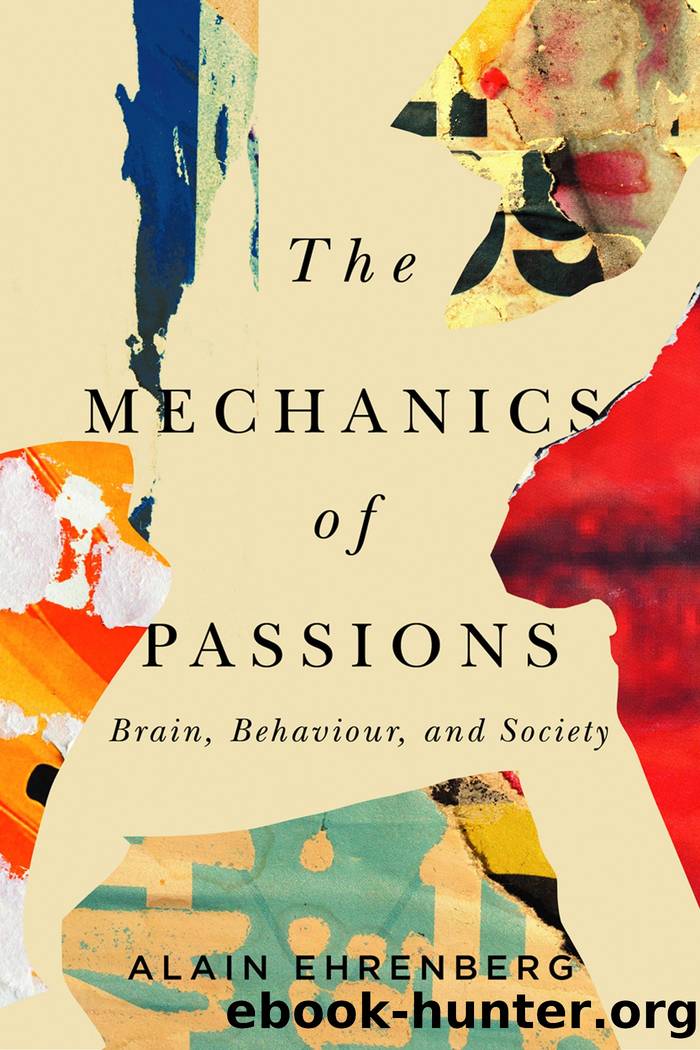The Mechanics of Passions: Brain, Behaviour, and Society by Alain Ehrenberg

Author:Alain Ehrenberg
Language: eng
Format: epub
Publisher: MQUP
Published: 2020-10-14T16:00:00+00:00
5
Exercises in Autonomy
Individualist Rituals to Reconstruct Oneâs Moral Being?
Each Self requires what was once a kingâs privilege, to have a distinctive Self, and plan a world in the form of some utopic project or theatrical production of its idiosyncrasy.
Pierre-Yves Pétillon, La Grand-Route. Espace et écriture en Amérique
After a session of cognitive remediation therapy, a patient suffering from schizophrenia tells the psychologist providing the treatment, âBefore I was handicapped, but thanks to our work, I hope to become handicapable.â1 What a profoundly lucid way of expressing a sociological definition, not only of the new viewpoint on the mentally ill, but also, going beyond psychiatry and mental health, on the establishment of a new individual with the generalization of the ideals of autonomy over the last half century.
âCognitive remediationâ describes a neuroscientific method of caring for and providing support to those with mental illness, which started its rise to prominence in the 1980s, as patients with serious psychiatric issues were essentially treated as outpatients. It originally articulates two cardinal notions in mental health, rehabilitation and recovery. The first term designates practices, and the second, a new idea for healing, but they are used interchangeably because their meanings are interdependent. They are central to this chapterâs subject, âexercises in autonomy.â
In this chapter and the following one, the emphasis will shift a bit. Up to this point, cognitive neuroscience was viewed through the lens of moral authority based on an aspect of individualist modernity. Now it is time to tackle the epistemological question brought up in the introduction: How far can we take the understanding of humans simply by knowing their brain and organism? Or, to use Maussâs words, In what way can there be no interval between the biological and the social? In order to answer that, these two chapters outline the way in which cognitive neuroscience is entirely involved with the individualâs existence, at the same time necessitating a reflection on the two main ways of reconstructing oneâs moral being in a mass individualist society embodied by psychoanalysis and cognitive neuroscience â or at least their practices.
In the past, handicap and ability were opposed (ability being aligned with autonomy); today, these two terms are associated by the degree of autonomy and the diversity of its forms. Autonomy is a relative concept. âHandicappedâ is a state, âhandicapableâ is a journey and, more precisely, has less to do with a cure than with personal transformation in the face of negativity, the difficulties of which are no doubt more intense, dramatic, and painful than those of the ordinary person, but not of another nature.
Recovery is the system of caring on which the ideal of hidden potential relies, hidden potential being this fundamental attitude in the face of adversity, contingency, or negativity. It is the institution of it. The guiding line of this system of action is, by casting the widest net possible, to develop individualsâ ability using exercises that will lead them on a path to personal transformation by being the agent of their own change.
Download
This site does not store any files on its server. We only index and link to content provided by other sites. Please contact the content providers to delete copyright contents if any and email us, we'll remove relevant links or contents immediately.
| Administration & Medicine Economics | Allied Health Professions |
| Basic Sciences | Dentistry |
| History | Medical Informatics |
| Medicine | Nursing |
| Pharmacology | Psychology |
| Research | Veterinary Medicine |
Bioenergetica by Alexander Lowen(1122)
Noise: A Flaw in Human Judgment by Sunstein Cass R. & Sibony Olivier & Kahneman Daniel(968)
The Data Detective by Tim Harford(939)
The Child in You by Stefanie Stahl(882)
Chatter by Ethan Kross(797)
The Science of Rapid Skill Acquisition by Peter Hollins(636)
Freedom by Sebastian Junger(629)
No Bad Parts by Richard C. Schwartz(600)
The Montessori Baby by Simone Davies(561)
Evolution Gone Wrong: The Curious Reasons Why Our Bodies Work by Alex Bezzerides(559)
The Quantum Psychiatrist: From Zero to Zen Using Evidence-Based Solutions Beyond Medication and Therapy by Biswas Dona(551)
Maps of Meaning: The Architecture of Belief by Jordan B. Peterson(548)
The Science of Self-Learning: How to Teach Yourself Anything, Learn More in Less Time, and Direct Your Own Education (Learning how to Learn Book 1) by Peter Hollins(518)
Anxiety For Dummies by Charles H. Elliott & Laura L. Smith(511)
Sadomasochism and the BDSM Community in the United States by Stephen K. Stein(497)
Disconnected by thomas Kersting(480)
Why Sex Doesn't Matter by Olivia Fane(479)
The Mechanics of Passions: Brain, Behaviour, and Society by Alain Ehrenberg(479)
Jung - The Key Ideas: Teach Yourself (TY Philosophy) by Ruth Snowden(466)
